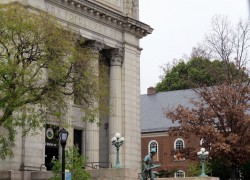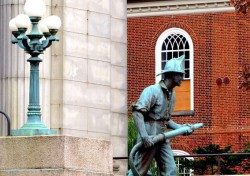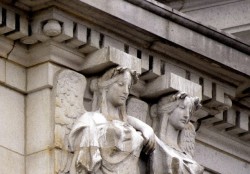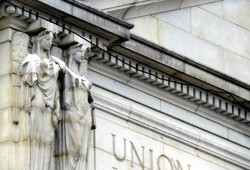[ezcol_1third]
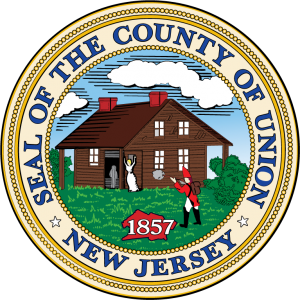
From the 15th to 17th Centuries, the Dutch and English were drawn to this area — then occupied by the Lenni Lenapi Indians (or Delaware tribe, as the Europeans called them) — because of its incredibly easy access by sea. They developed the first colonial settlements in the area because of its natural beauty, vast abundance of fertile fields and natural resources, and offer of personal freedom.
The development of the area was greatly helped by the criss-cross network of Indian trails, which became colonial roads and, centuries later, major highways.
In the historic Elizabethtown Purchase of 1664 — the Lenni Lanapi gave a group of English settlers title to an immense tract of land that extended from the Raritan to the Passaic Rivers, and westward for over thirty miles. (It is interesting to note that the Indians believed they were selling the rights to use the land for hunting, fishing, farming and such. The English concept of “owning” land was unknown to them at that time.)
The purchase led to the first permanent English settlement in New Jersey.
Elizabethtown was laid out along the Elizabeth River near the present Union County Courthouse. As the port of entry and first seat of New Jersey government, Elizabeth became a prominent and thriving economic center, and the leading settlement in the state. (It should also be noted that Warinanco and Matteo were two Indians whose names were later given to two County parks.)
In 1683, the General Assembly, meeting in Elizabethtown, divided East New Jersey into four counties: Bergen, Essex, Middlesex and Monmouth. What we know as Union County was originally a part of Essex County. With the growth in population and continuous division and sale of land parcels, Elizabethtown’s boundary lines continued to expand and divide. State legislature created the towns of Springfield (1793), Westfield (1794), Rahway (1804), Union (1808) and New Providence (1809).
The creation of Plainfield in 1847 fueled the movement to secede from Essex County, to create a new county better equipped to meet the needs of the southernmost towns. The animosities between Elizabethtown and Newark heightened in 1807 when Newark replaced Elizabethtown as Essex County’s seat of justice, and gradually overcame Elizabethtown in economic importance. It accelerated when Elizabeth incorporated in 1855.
[/ezcol_1third][ezcol_1third]
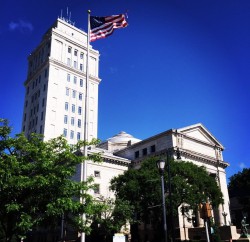
For more than 330 years, a government building has been located at the site of the present Courthouse at Broad Street and Rahway Avenue in Elizabeth. The Colonial counterpart, mentioned as early as 1668 as the Elizabethtown Meeting House, was adjacent to the historic First Presbyterian Church where many notable citizens are buried including Hannah Caldwell and her husband, Rev. James Caldwell, the “Fighting Parson.”
The location is steeped in history and lore. It was Hannah Caldwell’s alleged murder by British soldiers during the Revolutionary War that was the inspiration for the Union County Seal which is replicated on many brass doorknobs in the Courthouse. It is rumored by some that Mrs. Caldwell’s ghost walks the area of the cemetery and Courthouse on occasion.
Constructed by early settlers and destroyed in a Tory raid in 1780, the Meeting House was rebuilt in 1797 and razed again by fire in 1808. It was replaced in 1810 by a building described at the time as one of the most modern in the county.
The courthouse area has been the scene of many gatherings. General Winfield Scott, an Elizabeth resident and hero of the Mexican War, was welcomed by his fellow citizens on a raised platform in front of the Courthouse.
Until the incorporation of the city in 1855, every voter in Elizabeth was required to cast a ballot at the Courthouse. Many patriotic gatherings took place at the Courthouse where departing soldiers paraded on the green in front of the building.
An addition to the structure was built about 1857 when Union County broke from Essex County to become New Jersey’s youngest county.
The first offices in the building were those of the County Clerk, Surrogate, Sheriff and Board of Chosen Freeholders. The Prosecutor’s Office and three courts were added soon after. Wings were added periodically to house other agencies.
As Union County grew in size, a new county Courthouse was conceived and designed by architects Ackerman and Ross. In 1905 a three-story structure, with facilities for all main offices of county government, was opened.
The Classical Revival structure forms the central section of today’s layout with a three bay principal facade, portico and four Corinthian columns. Within 15 years, county government again outgrew the structure and in 1925 a seven-floor building, termed the Annex, and including a Hall of Records and County Jail, was added at a cost of approximately $600,000.
One of the best known interior features of the Courthouse is the rotunda. Open halls on the second and third floors view the entrance level below. Window and door openings are trimmed with quality crafted architectural details and classical moldings. At ceiling lev el, crafted gold moldings compliment the gold chandeliers that hang from the high ceilings.
Some courtrooms in the original building and tower addition contain the same architectural details as the rotunda.
In 1931, the 17-floor tower was added to the facility dictated by the need for more space. Designed by Elizabeth architects Oakley and Son at a cost of more than $1.2 million, the massive five bay square tower dominates the Elizabeth skyline. Its steel skeleton is covered with terra cotta and finished to imitate the granite exterior of the old section of the building.
The three-story portico on the south side, which fronts on Rahway Avenue, provides the tower with a visual base. The main building has a ground story platform with a flight of steps and four Tuscan columns. Many of the Superior Court of New Jersey courtrooms at the county seat are in the tall slender structure.
The Courthouse is listed on the State and National Registers of Historic Places. A modern, two-story entrance was opened in 2000 on Elizabethtown Plaza. Visitors are welcome at the Courthouse, and tours can be scheduled through the Union County Clerk’s Office.

In 1919, Union County Sheriff James E. Warner mourned the reeking pollution that was ruining the Rahway River, a place very dear and familiar to him since his childhood, when he fished in its clear lakes and streams. In a letter to the Cranford Citizen, Warner pleaded for salvation of the Rahway River. As a result, Cranford Township Committeeman D.C.N. Collins picked up the dream and dedicated himself to making it a reality. He wrote to the Elizabeth Daily Journal, “Think of Union County thirty years hence. Think what a splendid county this would be to live in if our system of streams and mountains and forests were owned by the county and restored to their elemental purity. Or think of what the county will be thirty years from now if they are not!”
With the enthusiastic support of more than 400 men and women, the Union County Park Association was organized to urge the formation of a Park Commission. In order to appoint a Park Commission, State law mandated that the County have a minimum population of 200,000. When the 1920 census indicated that Union County’s population fell short of that number by 100, Cranford residents canvassed every home to get signed affidavits from anyone who had not been present during the official census. The population of Union County was 200,157.
In April of 1921, Superior Court Justice James J. Bergen was petitioned to appoint a temporary commission to study the feasibility of a Park Commission. On April 30, a temporary commission was named and given $10,000.00 and two years to complete the study. In less than five months, the group finished the study and returned $8,391.00 of the money. The emphasis of the report was to move quickly, before the available open space was gone. On the November 8, 1921 ballot, voters were asked to approve a permanent five-member Park Commission and $2.5 million to be spent at the commission’s discretion. Despite opposition from the more populated areas of the County, the ballot was passed.
On November 19, 1921, Henry S. Chatfield, Charles A. Reed, Arthur R. Wendell, Charles Hansen and Caxton Brown were officially appointed commissioners of the newly formed Union County Park Commission. In December of that year, the commissioners met to begin the task of building a park system. Over the next few years, potential park land was visited, landscape architects were hired and Princeton graduate W. Richmond Tracy, Chief Bridge Builder for the Bronx River Parkway, became the first man on the Park Commission payroll as Engineer-Secretary.
The Park Commission envisioned a park system which would someday be interconnecting, following the credo:
The plan of any County Park System should be based on the principle that such system would benefit the whole population of the County, that it should be convenient and easily accessible to the large centers of population, and that, above all else, it should take over and preserve for park purposes land adaptable for parks before it is utilized for residences, factories or other purposes.
By June of 1925, the Park Commission had spent $1.7 million to purchase and develop 2,000 acres of land and had options for condemnation proceedings on another 1,000 acres. The Park Commission pushed through a referendum for an additional $1.5 million and another $1 million in 1928. By 1930, the Union County Park System encompassed 4,160 acres of land.
With the reduction of the six-day work week to five days, leisure time increased and the need for recreational facilities and activities became more important than ever. In 1927, the Commission hired F.S. Matthewson as the first full-time Recreation Director in any county park system in the United States. Within a year, Mr. Matthewson proved the value of having planned recreational programs by increasing playground programs, forming day camps, organizing sports leagues and numerous county-wide events.
Over the next 50 years, the Park Commission continued to acquire and develop parkland and recreational facilities to meet the needs of the growing population.
In 1978, through public referendum, the Union County Park Commission was abolished and the County of Union, Department of Parks and Recreation was formed. Today, with over 6,760 acres of land, the County carries on the original Park Commission’s dream and credo, to develop a park system, “To Benefit the Whole Population.”

